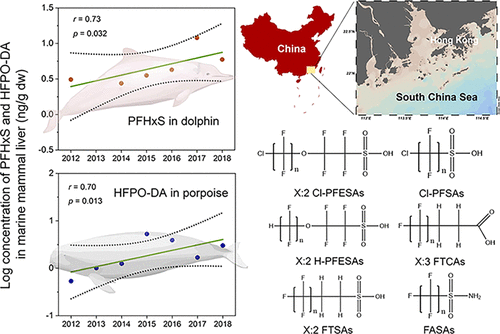当前位置:
X-MOL 学术
›
Environ. Sci. Technol.
›
论文详情
Our official English website, www.x-mol.net, welcomes your feedback! (Note: you will need to create a separate account there.)
Target, Nontarget, and Suspect Screening and Temporal Trends of Per- and Polyfluoroalkyl Substances in Marine Mammals from the South China Sea
Environmental Science & Technology ( IF 11.4 ) Pub Date : 2021-01-04 , DOI: 10.1021/acs.est.0c06685 Qi Wang 1, 2, 3 , Yuefei Ruan 1, 2, 3 , Linjie Jin 1, 2 , Xiaohua Zhang 4 , Jing Li 1, 3 , Yuhe He 5 , Si Wei 6 , James C.W. Lam 4 , Paul K.S. Lam 1, 2, 3
Environmental Science & Technology ( IF 11.4 ) Pub Date : 2021-01-04 , DOI: 10.1021/acs.est.0c06685 Qi Wang 1, 2, 3 , Yuefei Ruan 1, 2, 3 , Linjie Jin 1, 2 , Xiaohua Zhang 4 , Jing Li 1, 3 , Yuhe He 5 , Si Wei 6 , James C.W. Lam 4 , Paul K.S. Lam 1, 2, 3
Affiliation

|
Per- and polyfluoroalkyl substances (PFASs) have been manufactured and widely used for over 60 years. Currently, there are thousands of marketed PFASs, but only dozens of them are routinely monitored. This work involved target, nontarget, and suspect screening of PFASs in the liver of Indo-Pacific humpback dolphin (Sousa chinensis) and finless porpoise (Neophocaena phocaenoides), two resident marine mammals in the South China Sea, stranded between 2012 and 2018. Among the 21 target PFASs, perfluorooctane sulfonate and 6:2 chlorinated polyfluoroalkyl ether sulfonate (6:2 Cl-PFESA) predominated in the samples, accounting for 46 and 30% of the total PFASs, respectively. Significantly higher total target PFAS concentrations (p < 0.05) were found in dolphin liver samples [3.23 × 103 ± 2.63 × 103 ng/g dry weight (dw)] than in porpoise liver samples (2.63 × 103 ± 1.10 × 103 ng/g dw). Significant increasing temporal trends (p < 0.05) were found in the concentrations of two emerging PFASs, perfluoroethylcyclohexane sulfonate and 2,3,3,3-tetrafluoro-2-propanoate in porpoises, indicating increasing pollution by these emerging PFASs. Forty-four PFASs from 9 classes were additionally identified by nontarget and suspect screening, among which 15 compounds were reported for the first time in marine mammals. A primary risk assessment showed that the emerging PFAS 6:2 Cl-PFESA could have possible adverse effects in terms of reproductive injury potential on most of the investigated cetaceans.
中文翻译:

南海海洋哺乳动物中全氟和多氟烷基物质的目标,非目标和可疑筛查及时间趋势
全氟烷基物质和多氟烷基物质(PFAS)已被制造并广泛使用了60多年。当前,市场上有成千上万种PFAS,但其中只有几十个受到常规监控。这项工作涉及对印度洋-太平洋座头海豚(Sousa chinensis)和无鳍海豚(Neophocaena phocaenoides)(南海的两种常驻海洋哺乳动物)的肝脏中的PFAS进行目标,非目标和可疑的筛选,这是2012年至2018年之间搁浅的两种。样品中占主导地位的是21种目标PFAS,全氟辛烷磺酸盐和6:2氯化多氟烷基醚磺酸盐(6:2 Cl-PFESA)分别占总PFAS的46%和30%。PFAS的总目标浓度明显更高(p<0.05)在海豚肝样品中发现[3.23×10 3 ±2.63×10 3 ng / g干重(dw)],而在海豚肝样品中发现(2.63×10 3 ±1.10×10 3 ng / g dw)。时间趋势显着增加(p在海豚中,两种新兴PFAS的浓度(全氟乙基环己烷磺酸盐和2,3,3,3-四氟-2-丙酸酯)的浓度<0.05),表明这些新兴PFAS的污染增加。通过非目标和可疑筛查还额外鉴定了来自9类的44种PFAS,其中海洋哺乳动物首次报道了15种化合物。初步风险评估表明,就大多数被调查的鲸类而言,就生殖伤害潜力而言,正在出现的PFAS 6:2 Cl-PFESA可能具有不利影响。
更新日期:2021-01-19
中文翻译:

南海海洋哺乳动物中全氟和多氟烷基物质的目标,非目标和可疑筛查及时间趋势
全氟烷基物质和多氟烷基物质(PFAS)已被制造并广泛使用了60多年。当前,市场上有成千上万种PFAS,但其中只有几十个受到常规监控。这项工作涉及对印度洋-太平洋座头海豚(Sousa chinensis)和无鳍海豚(Neophocaena phocaenoides)(南海的两种常驻海洋哺乳动物)的肝脏中的PFAS进行目标,非目标和可疑的筛选,这是2012年至2018年之间搁浅的两种。样品中占主导地位的是21种目标PFAS,全氟辛烷磺酸盐和6:2氯化多氟烷基醚磺酸盐(6:2 Cl-PFESA)分别占总PFAS的46%和30%。PFAS的总目标浓度明显更高(p<0.05)在海豚肝样品中发现[3.23×10 3 ±2.63×10 3 ng / g干重(dw)],而在海豚肝样品中发现(2.63×10 3 ±1.10×10 3 ng / g dw)。时间趋势显着增加(p在海豚中,两种新兴PFAS的浓度(全氟乙基环己烷磺酸盐和2,3,3,3-四氟-2-丙酸酯)的浓度<0.05),表明这些新兴PFAS的污染增加。通过非目标和可疑筛查还额外鉴定了来自9类的44种PFAS,其中海洋哺乳动物首次报道了15种化合物。初步风险评估表明,就大多数被调查的鲸类而言,就生殖伤害潜力而言,正在出现的PFAS 6:2 Cl-PFESA可能具有不利影响。



























 京公网安备 11010802027423号
京公网安备 11010802027423号